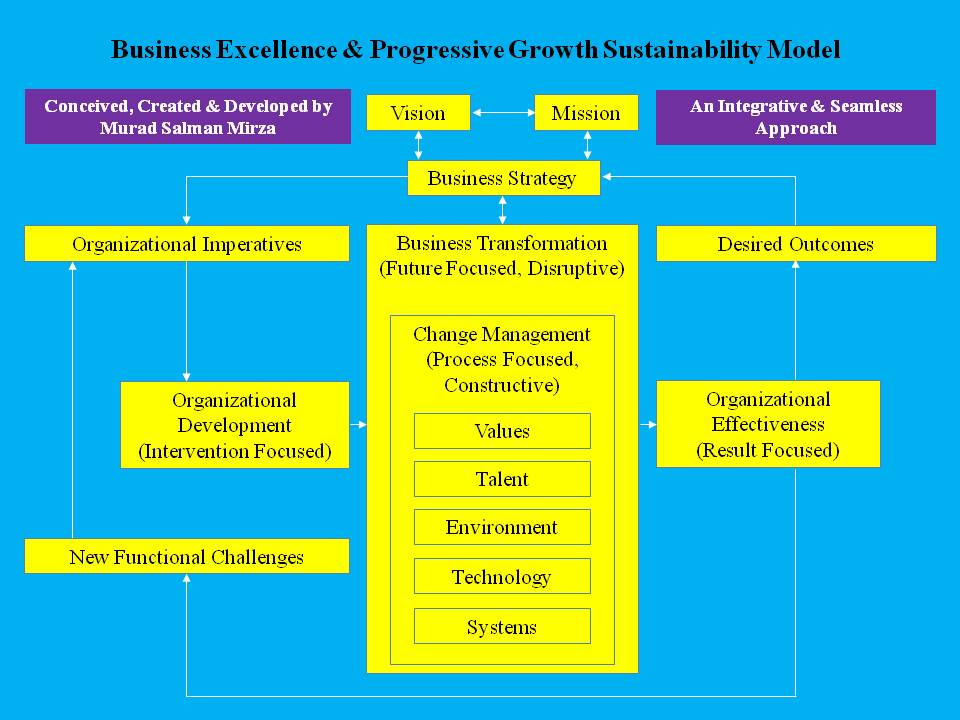An Integrative Model for Achieving Sustainable Business Excellence and Progressive Business Growth.
Professional fields are often strewn with terminologies that confound the uninitiated and rally the peers/colleagues around a common language. However, this can also lead to multiple interpretations and divergence of viewpoints that can dilute the core purpose of effective application of key concepts. Consequently, success is often measured in terms of avoiding failures, rather than, learning from missteps and consolidating gains on a long-term basis. This conventionalises risk aversion as senior management gets increasingly addicted to quarterly results to placate impatient shareholders who are hooked on quicker positive returns within a highly sensitized market hinging on precarious economic outlooks.
Another key factor in the respective context is the profound advancement of technology that is fueling the need for supremely efficient operations and lowering the threshold for tolerating failure. Innovation has become a necessary element of the genetic makeup within progressive organizations and ‘human factor’ is steadily being marginalized in favor of automated/autonomous ‘user-friendly’ technologies. The respective trend is expected to grow exponentially in the future as Artificial Intelligence (AI)/Super-Advanced Robotics/Hybrid Lifeforms take control of various functions that are/were considered the exclusive realms of human ingenuity. Consequently, staying relevant in such transformative times requires an organization to be astutely agile in congruence with its business strategies under the umbrella of a Sagacious Vision and an Enlightened Mission.
The following model is being presented as a sustainable solution for successfully navigating through the labyrinth of weighty terminologies and ensure long-term relevance of a progressive organization in rapidly evolving markets across the world:

Note:
The aforementioned model assumes honest, judicious, astute and incisive application in a progressive organization without fear or favor.
The respective model is primarily driven by a galvanizing Vision and a robust Mission germinating in a conducive Business Strategy based upon the dynamics of the influential internal and external factors. This leads to the formulation of the Organisational Imperatives that are translated into Organisational Development initiatives to commence timely and focused interventions in an efficient and effective manner. The scope, scale and approach of the respective interventions is determined by the following two key pathways:
- Process Focused, Constructive (Change Management)
- Future Focused, Disruptive (Business Transformation)
Any improvement methodology (normative, customized) can be applied to achieve desired results once the broader parameters of choosing the desired pathway are defined, debated and finalized with focus areas gravitating towards the following five key pillars:
Values
Concentrating on everything associated with aspects pertaining to Organisational Culture
Talent
Concentrating on everything associated with aspects pertaining to Talent Management
Environment
Concentrating on everything associated with aspects pertaining to Employee Wellness & Wellbeing and Corporate Social Responsibility (CSR)
Technology
Concentrating on everything associated with aspects pertaining to Technological Innovations
Systems
Concentrating on everything associated with interactive elements pertaining to Management Systems, e.g., Operational Strategies, Tactical Plans, Methodologies, Processes, Policies, Procedures, Rules, Regulations, etc.
The quality of change/transformation is assured by timely and insightful corporate management reviews, undertaken at suitably defined intervals, by gauging alignment with the overall business strategy and ensuring robust & effective corrective/preventive actions. Consequently, Organisational Effectiveness is achieved as actual results strongly match with planned objectives/goals. The desired outcomes with lessons learnt are then fed back into updating the ‘Knowledge Bank’ for formulating future business strategies on long-term basis. Any new functional challenges in the short-term are carefully assessed and converted into Organisational Imperatives on merit to follow the same aforementioned structured approach.
This model has been designed to be cyclical/closed-loop in nature to embed the principle of continuous improvement within its core functionality to synergistically integrate with the ‘innovation’ mindset that is pervading the corporate landscape. The level of success achieved with this approach is directly proportional to the quality of leadership at the organization’s helm. Therefore, it is imperative that progressive leadership development and astute succession planning are tightly knit within the fabric of the organization to safeguard against unrelenting competitors/disruptive innovators. The price for excellence should never discount the cost of complacency…








